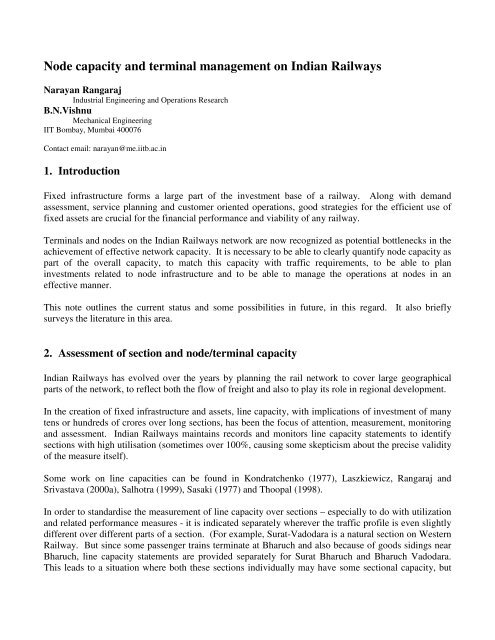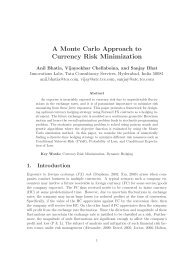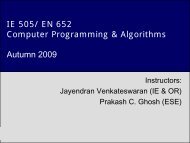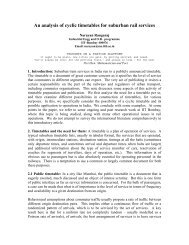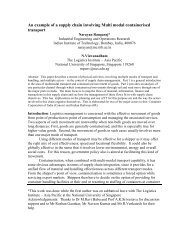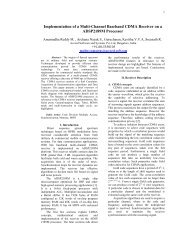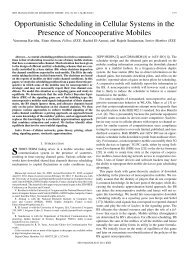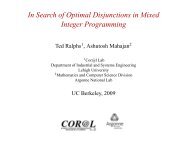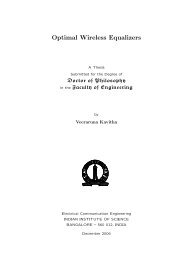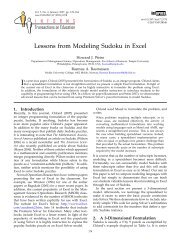Node capacity and terminal management on Indian Railways
Node capacity and terminal management on Indian Railways
Node capacity and terminal management on Indian Railways
Create successful ePaper yourself
Turn your PDF publications into a flip-book with our unique Google optimized e-Paper software.
<str<strong>on</strong>g>Node</str<strong>on</strong>g> <str<strong>on</strong>g>capacity</str<strong>on</strong>g> <str<strong>on</strong>g>and</str<strong>on</strong>g> <str<strong>on</strong>g>terminal</str<strong>on</strong>g> <str<strong>on</strong>g>management</str<strong>on</strong>g> <strong>on</strong> <strong>Indian</strong> <strong>Railways</strong><br />
Narayan Rangaraj<br />
Industrial Engineering <str<strong>on</strong>g>and</str<strong>on</strong>g> Operati<strong>on</strong>s Research<br />
B.N.Vishnu<br />
Mechanical Engineering<br />
IIT Bombay, Mumbai 400076<br />
C<strong>on</strong>tact email: narayan@me.iitb.ac.in<br />
1. Introducti<strong>on</strong><br />
Fixed infrastructure forms a large part of the investment base of a railway. Al<strong>on</strong>g with dem<str<strong>on</strong>g>and</str<strong>on</strong>g><br />
assessment, service planning <str<strong>on</strong>g>and</str<strong>on</strong>g> customer oriented operati<strong>on</strong>s, good strategies for the efficient use of<br />
fixed assets are crucial for the financial performance <str<strong>on</strong>g>and</str<strong>on</strong>g> viability of any railway.<br />
Terminals <str<strong>on</strong>g>and</str<strong>on</strong>g> nodes <strong>on</strong> the <strong>Indian</strong> <strong>Railways</strong> network are now recognized as potential bottlenecks in the<br />
achievement of effective network <str<strong>on</strong>g>capacity</str<strong>on</strong>g>. It is necessary to be able to clearly quantify node <str<strong>on</strong>g>capacity</str<strong>on</strong>g> as<br />
part of the overall <str<strong>on</strong>g>capacity</str<strong>on</strong>g>, to match this <str<strong>on</strong>g>capacity</str<strong>on</strong>g> with traffic requirements, to be able to plan<br />
investments related to node infrastructure <str<strong>on</strong>g>and</str<strong>on</strong>g> to be able to manage the operati<strong>on</strong>s at nodes in an<br />
effective manner.<br />
This note outlines the current status <str<strong>on</strong>g>and</str<strong>on</strong>g> some possibilities in future, in this regard. It also briefly<br />
surveys the literature in this area.<br />
2. Assessment of secti<strong>on</strong> <str<strong>on</strong>g>and</str<strong>on</strong>g> node/<str<strong>on</strong>g>terminal</str<strong>on</strong>g> <str<strong>on</strong>g>capacity</str<strong>on</strong>g><br />
<strong>Indian</strong> <strong>Railways</strong> has evolved over the years by planning the rail network to cover large geographical<br />
parts of the network, to reflect both the flow of freight <str<strong>on</strong>g>and</str<strong>on</strong>g> also to play its role in regi<strong>on</strong>al development.<br />
In the creati<strong>on</strong> of fixed infrastructure <str<strong>on</strong>g>and</str<strong>on</strong>g> assets, line <str<strong>on</strong>g>capacity</str<strong>on</strong>g>, with implicati<strong>on</strong>s of investment of many<br />
tens or hundreds of crores over l<strong>on</strong>g secti<strong>on</strong>s, has been the focus of attenti<strong>on</strong>, measurement, m<strong>on</strong>itoring<br />
<str<strong>on</strong>g>and</str<strong>on</strong>g> assessment. <strong>Indian</strong> <strong>Railways</strong> maintains records <str<strong>on</strong>g>and</str<strong>on</strong>g> m<strong>on</strong>itors line <str<strong>on</strong>g>capacity</str<strong>on</strong>g> statements to identify<br />
secti<strong>on</strong>s with high utilisati<strong>on</strong> (sometimes over 100%, causing some skepticism about the precise validity<br />
of the measure itself).<br />
Some work <strong>on</strong> line capacities can be found in K<strong>on</strong>dratchenko (1977), Laszkiewicz, Rangaraj <str<strong>on</strong>g>and</str<strong>on</strong>g><br />
Srivastava (2000a), Salhotra (1999), Sasaki (1977) <str<strong>on</strong>g>and</str<strong>on</strong>g> Thoopal (1998).<br />
In order to st<str<strong>on</strong>g>and</str<strong>on</strong>g>ardise the measurement of line <str<strong>on</strong>g>capacity</str<strong>on</strong>g> over secti<strong>on</strong>s – especially to do with utilizati<strong>on</strong><br />
<str<strong>on</strong>g>and</str<strong>on</strong>g> related performance measures - it is indicated separately wherever the traffic profile is even slightly<br />
different over different parts of a secti<strong>on</strong>. (For example, Surat-Vadodara is a natural secti<strong>on</strong> <strong>on</strong> Western<br />
Railway. But since some passenger trains terminate at Bharuch <str<strong>on</strong>g>and</str<strong>on</strong>g> also because of goods sidings near<br />
Bharuch, line <str<strong>on</strong>g>capacity</str<strong>on</strong>g> statements are provided separately for Surat Bharuch <str<strong>on</strong>g>and</str<strong>on</strong>g> Bharuch Vadodara.<br />
This leads to a situati<strong>on</strong> where both these secti<strong>on</strong>s individually may have some secti<strong>on</strong>al <str<strong>on</strong>g>capacity</str<strong>on</strong>g>, but
where it is accepted that the larger secti<strong>on</strong> cannot h<str<strong>on</strong>g>and</str<strong>on</strong>g>le that number of trains because the intermediate<br />
stati<strong>on</strong> cannot h<str<strong>on</strong>g>and</str<strong>on</strong>g>le that traffic.)<br />
The situati<strong>on</strong> is compounded as far as network <str<strong>on</strong>g>capacity</str<strong>on</strong>g> is c<strong>on</strong>cerned, where it may be accepted that<br />
Bharuch Vadodara <str<strong>on</strong>g>and</str<strong>on</strong>g> Vadodara Godhra may have some secti<strong>on</strong>al <str<strong>on</strong>g>capacity</str<strong>on</strong>g>, but it may well be that<br />
Vadodara yard cannot h<str<strong>on</strong>g>and</str<strong>on</strong>g>le this number. Partly, these difficulties, added to the problems of measuring<br />
n<strong>on</strong>-homogeneous traffic have led to an obscuring of the measurement of some crucial infrastructural<br />
bottlenecks. The issue of defining line capacities for n<strong>on</strong>-homogeneous traffic has been briefly<br />
discussed in Rangaraj <str<strong>on</strong>g>and</str<strong>on</strong>g> Srivastava (2000a) <str<strong>on</strong>g>and</str<strong>on</strong>g> also by the methodology proposed by the L<strong>on</strong>g Range<br />
Decisi<strong>on</strong> Support System (LRDSS) of the <strong>Indian</strong> <strong>Railways</strong> (e.g. see Salhotra (1999)).<br />
As regards node capacities, there are two major difficulties in assessment. One is that a node <strong>on</strong> a<br />
railway network can have traffic of different types <str<strong>on</strong>g>and</str<strong>on</strong>g> a scheduling model of some kind is required to<br />
route the traffic in a safe <str<strong>on</strong>g>and</str<strong>on</strong>g> effective manner. Only then can the <str<strong>on</strong>g>capacity</str<strong>on</strong>g> of the node to h<str<strong>on</strong>g>and</str<strong>on</strong>g>le traffic<br />
be assessed. The sec<strong>on</strong>d difficulty is to establish a numerical measure for <str<strong>on</strong>g>capacity</str<strong>on</strong>g> in the light of the<br />
mixed activities at a node. A number such as the maximum number of trains h<str<strong>on</strong>g>and</str<strong>on</strong>g>led in a given<br />
directi<strong>on</strong> is not adequate, as a measure, as it cannot be translated into effective service measures or used<br />
in judging investment effectiveness.<br />
A possible soluti<strong>on</strong> to this is the following. An answer to the questi<strong>on</strong> "What time delay does a st<str<strong>on</strong>g>and</str<strong>on</strong>g>ard<br />
type of unscheduled freight train face, arriving at a r<str<strong>on</strong>g>and</str<strong>on</strong>g>om point during the day, while passing through<br />
any part of the rail network?" If this answer is c<strong>on</strong>siderably more than the normal free running time of<br />
the train (given its speed characteristics <str<strong>on</strong>g>and</str<strong>on</strong>g> the secti<strong>on</strong>/yard speed restricti<strong>on</strong>s), it can be c<strong>on</strong>cluded that<br />
that part of the network (whether node or secti<strong>on</strong> or a bit of both) is c<strong>on</strong>gested.<br />
Given the line capacities of secti<strong>on</strong>s adjacent to a node, the report by Thoopal (1998) presents a c<strong>on</strong>crete<br />
method to estimate the bottleneck effect of a node. In this, in additi<strong>on</strong> to the platform occupancy charts<br />
of known movements of passenger trains, all possible shunting <str<strong>on</strong>g>and</str<strong>on</strong>g> other movements due to crew<br />
change, loco change <str<strong>on</strong>g>and</str<strong>on</strong>g> other operati<strong>on</strong>s are superimposed. The residual <str<strong>on</strong>g>capacity</str<strong>on</strong>g> <strong>on</strong> platform <str<strong>on</strong>g>and</str<strong>on</strong>g> n<strong>on</strong>platform<br />
lines are used to attempt to h<str<strong>on</strong>g>and</str<strong>on</strong>g>le the freight trains according to some arrival pattern from<br />
neighbouring secti<strong>on</strong>s. This highlights the loss of <str<strong>on</strong>g>capacity</str<strong>on</strong>g> due to the node. The study clearly<br />
establishes the seriousness of the problem in many c<strong>on</strong>gested parts of the <strong>Indian</strong> Railway network <str<strong>on</strong>g>and</str<strong>on</strong>g><br />
suggests a number of c<strong>on</strong>crete measures to address the problem.<br />
3. Classificati<strong>on</strong> of nodes <str<strong>on</strong>g>and</str<strong>on</strong>g> <str<strong>on</strong>g>terminal</str<strong>on</strong>g>s<br />
For c<strong>on</strong>venience, we can describe the <str<strong>on</strong>g>management</str<strong>on</strong>g> of fixed infrastructure facilities in the following three<br />
categories: 1) passenger dominant facilities, 2) freight h<str<strong>on</strong>g>and</str<strong>on</strong>g>ling facilities <str<strong>on</strong>g>and</str<strong>on</strong>g> 3) maintenance oriented<br />
facilities.<br />
Although there could be an overlap of these activities in some facilities, the above provides a useful<br />
classificati<strong>on</strong> of activities, investments <str<strong>on</strong>g>and</str<strong>on</strong>g> strategies that could be followed in each type of facility. The<br />
overlap is a result of a mix of c<strong>on</strong>cerns that are inevitable in activities such as the railways, where<br />
comm<strong>on</strong> facilities are used for a variety of purposes. To that extent, the planning <str<strong>on</strong>g>and</str<strong>on</strong>g> operati<strong>on</strong> of these<br />
facilities cannot be segregated into watertight compartments as far as objectives or strategies go.
With this in mind, the characteristics of these different types of facilities are discussed in a little more<br />
detail below.<br />
1) Passenger dominant facilities: These are secti<strong>on</strong>s <str<strong>on</strong>g>and</str<strong>on</strong>g> stati<strong>on</strong>s (including juncti<strong>on</strong> stati<strong>on</strong>s) <strong>on</strong> the<br />
railway network. In such facilities, there is a fair amount of homogeneous traffic (often with a<br />
significant fracti<strong>on</strong> of traffic being of the scheduled or timetabled variety, applicable to passenger<br />
trains). In terms of objectives, there are customer driven schedule c<strong>on</strong>straints <str<strong>on</strong>g>and</str<strong>on</strong>g> there is a c<strong>on</strong>cern for<br />
maintaining punctuality <str<strong>on</strong>g>and</str<strong>on</strong>g> to follow timed activities as best as possible. A good measure of the<br />
operating effectiveness of such facilities would be the extent of slack provided in the timings of<br />
passenger trains that use such facilities.<br />
Some papers that deal with modeling passenger-dominated facilities are Zanelweld et al (1995,1996,<br />
2001).<br />
2) Freight h<str<strong>on</strong>g>and</str<strong>on</strong>g>ling facilities: These are exemplified by goods yards <str<strong>on</strong>g>and</str<strong>on</strong>g> sidings, loading <str<strong>on</strong>g>and</str<strong>on</strong>g><br />
unloading points for bulk traffic, <str<strong>on</strong>g>and</str<strong>on</strong>g> facilities such as c<strong>on</strong>tainer <str<strong>on</strong>g>terminal</str<strong>on</strong>g>s. In such facilities, the major<br />
objectives are to do with throughput or turnaround (rather than any specific time of completi<strong>on</strong>) <str<strong>on</strong>g>and</str<strong>on</strong>g><br />
utilisati<strong>on</strong> of facilities. C<strong>on</strong>venti<strong>on</strong>ally, the major bulk freight customers of the railways would be<br />
h<str<strong>on</strong>g>and</str<strong>on</strong>g>led at such facilities. Daganzo (1986, 1987a, 1987b), <str<strong>on</strong>g>and</str<strong>on</strong>g> Daganzo et al (1983) give some insights<br />
into the operati<strong>on</strong>s that take place <str<strong>on</strong>g>and</str<strong>on</strong>g> their modeling.<br />
3) Maintenance oriented facilities: These are facilities, such as EMU car sheds <str<strong>on</strong>g>and</str<strong>on</strong>g> loco sheds. These<br />
facilities are somewhat fewer in number, but are still important in the overall effectiveness of operati<strong>on</strong>s.<br />
4. Operati<strong>on</strong>s <str<strong>on</strong>g>management</str<strong>on</strong>g> practices <strong>on</strong> <strong>Indian</strong> <strong>Railways</strong><br />
We briefly outline some operating practices <strong>on</strong> <strong>Indian</strong> <strong>Railways</strong> <str<strong>on</strong>g>and</str<strong>on</strong>g> discuss opti<strong>on</strong>s <str<strong>on</strong>g>and</str<strong>on</strong>g> strategies in the<br />
coming years.<br />
4.1 C<strong>on</strong>trol regime: The c<strong>on</strong>trol regime <strong>on</strong> <strong>Indian</strong> <strong>Railways</strong> is secti<strong>on</strong> oriented, for historical reas<strong>on</strong>s.<br />
This was appropriate <str<strong>on</strong>g>and</str<strong>on</strong>g> c<strong>on</strong>tinues to be so, when secti<strong>on</strong>al <str<strong>on</strong>g>capacity</str<strong>on</strong>g> is in fact a likely bottleneck in<br />
resources <str<strong>on</strong>g>and</str<strong>on</strong>g> where secti<strong>on</strong>al resources need to be optimally allocated. This has lead to a situati<strong>on</strong><br />
where c<strong>on</strong>gested nodes are managed through a largely informal structure of communicati<strong>on</strong> between<br />
secti<strong>on</strong> c<strong>on</strong>trollers of adjacent secti<strong>on</strong>s, together with cabins which c<strong>on</strong>trol the movement through some<br />
key points. A limitati<strong>on</strong> of these procedures as far as node <str<strong>on</strong>g>management</str<strong>on</strong>g> is c<strong>on</strong>cerned is that <strong>on</strong> a typical<br />
c<strong>on</strong>trol chart, all the stati<strong>on</strong> resources are bunched together at <strong>on</strong>e locati<strong>on</strong> (<strong>on</strong> the vertical axis) <str<strong>on</strong>g>and</str<strong>on</strong>g><br />
detailed decisi<strong>on</strong>s such as loop/platform allocati<strong>on</strong> are d<strong>on</strong>e <strong>on</strong>ly by the experience of the secti<strong>on</strong><br />
c<strong>on</strong>troller.<br />
4.2 Organisati<strong>on</strong>al <str<strong>on</strong>g>and</str<strong>on</strong>g> <str<strong>on</strong>g>management</str<strong>on</strong>g> structure: It is often the case that nodes are at the boundaries of<br />
divisi<strong>on</strong>s or sometimes z<strong>on</strong>es <strong>on</strong> the <strong>Indian</strong> <strong>Railways</strong>. This naturally means that under the normal<br />
quantitative performance measures used at the secti<strong>on</strong>al, divisi<strong>on</strong>al <str<strong>on</strong>g>and</str<strong>on</strong>g> z<strong>on</strong>al levels, the performance of<br />
the node itself may be suboptimal. In those situati<strong>on</strong>s where the node is in fact a bottleneck in the
network c<strong>on</strong>text, this could be crucial in determining overall performance. At the very least, c<strong>on</strong>trol of<br />
traffic at such interface nodes requires additi<strong>on</strong>al efforts in communicati<strong>on</strong> <str<strong>on</strong>g>and</str<strong>on</strong>g> sharing of priorities.<br />
4.3 Area c<strong>on</strong>trol: Although <strong>Indian</strong> <strong>Railways</strong> has largely moved away from the marshalling yard set up,<br />
where trains would be classified <str<strong>on</strong>g>and</str<strong>on</strong>g> formed, in some yards, area c<strong>on</strong>trol for the purposes of train<br />
examinati<strong>on</strong>, loco attachment <str<strong>on</strong>g>and</str<strong>on</strong>g> sometimes loading <str<strong>on</strong>g>and</str<strong>on</strong>g> unloading, is practiced. Area c<strong>on</strong>trol charts,<br />
which represent the various lines available for h<str<strong>on</strong>g>and</str<strong>on</strong>g>ling traffic, are used for this purpose. It is worth<br />
examining whether these principles can be used for h<str<strong>on</strong>g>and</str<strong>on</strong>g>ling traffic at juncti<strong>on</strong> stati<strong>on</strong>s.<br />
4.4 Operating practices: A cascading impact of delays <str<strong>on</strong>g>and</str<strong>on</strong>g> detenti<strong>on</strong>s due to nodes are often evident in<br />
reviews of operati<strong>on</strong>s. To provide more flexibility in h<str<strong>on</strong>g>and</str<strong>on</strong>g>ling traffic at nodes, it is comm<strong>on</strong> to see<br />
signaling measures such as automatic signaling or multiple lines or twin single line operati<strong>on</strong> for a few<br />
block secti<strong>on</strong> <strong>on</strong> every secti<strong>on</strong> leading to a c<strong>on</strong>gested node. Other practices such as loco change or crew<br />
change rati<strong>on</strong>alizati<strong>on</strong> are d<strong>on</strong>e to improve the flow of traffic at nodes.<br />
4.5 Freight <str<strong>on</strong>g>terminal</str<strong>on</strong>g> <str<strong>on</strong>g>management</str<strong>on</strong>g>: The <str<strong>on</strong>g>management</str<strong>on</strong>g> of freight <str<strong>on</strong>g>terminal</str<strong>on</strong>g>s is an important <strong>on</strong>e in the<br />
<strong>Indian</strong> <strong>Railways</strong> c<strong>on</strong>text, <str<strong>on</strong>g>and</str<strong>on</strong>g> it is an important part of the <strong>on</strong>going phase of the LRDSS project. There<br />
are a variety of technological <str<strong>on</strong>g>and</str<strong>on</strong>g> operati<strong>on</strong>al opti<strong>on</strong>s to increase the turnaround of rolling stock, to<br />
reduce customer delays <str<strong>on</strong>g>and</str<strong>on</strong>g> increase node level performance. Some of these measures are Engine-<strong>on</strong>load,<br />
integrated train maintenance procedures, closed circuit movement of rakes etc. In the <strong>Indian</strong><br />
<strong>Railways</strong> c<strong>on</strong>text, some of these principles are outlined in Thoopal (1998) <str<strong>on</strong>g>and</str<strong>on</strong>g> other studies.<br />
4.6 Supply chain <str<strong>on</strong>g>management</str<strong>on</strong>g>: Some principles of supply chain <str<strong>on</strong>g>management</str<strong>on</strong>g> can be applied to the<br />
issue of <str<strong>on</strong>g>management</str<strong>on</strong>g> of freight <str<strong>on</strong>g>and</str<strong>on</strong>g> passenger <str<strong>on</strong>g>terminal</str<strong>on</strong>g>s. Some of these, from an IT perspective, are<br />
listed in Rangaraj <str<strong>on</strong>g>and</str<strong>on</strong>g> Srivastava (2000b).<br />
4.7 Examples <str<strong>on</strong>g>and</str<strong>on</strong>g> case studies: Several internal studies at Railway Staff College, Vadodara <str<strong>on</strong>g>and</str<strong>on</strong>g> other<br />
instituti<strong>on</strong>s provide rich insight to the issues at particular nodes. Such studies have proposed diagnostic<br />
measures, such as the average throughput time taken by freight trains through a node, <str<strong>on</strong>g>and</str<strong>on</strong>g> have listed a<br />
number of engineering <str<strong>on</strong>g>and</str<strong>on</strong>g> managerial opti<strong>on</strong>s to improve node performance.<br />
5. Models for estimating node <str<strong>on</strong>g>capacity</str<strong>on</strong>g> <str<strong>on</strong>g>and</str<strong>on</strong>g> models for managing node operati<strong>on</strong>s<br />
There is a very large literature in the area of railway operati<strong>on</strong>s <str<strong>on</strong>g>and</str<strong>on</strong>g> <str<strong>on</strong>g>management</str<strong>on</strong>g>, which deal with<br />
theoretical models for estimating node <str<strong>on</strong>g>capacity</str<strong>on</strong>g> <str<strong>on</strong>g>and</str<strong>on</strong>g> for managing node operati<strong>on</strong>s. We provide a<br />
representative sample of the literature, with a few comments.<br />
5.1 An initial classificati<strong>on</strong> of models: The models for assessing node <str<strong>on</strong>g>capacity</str<strong>on</strong>g> <str<strong>on</strong>g>and</str<strong>on</strong>g> for <str<strong>on</strong>g>management</str<strong>on</strong>g> of<br />
node operati<strong>on</strong>s can be broadly classified into: 1) Planning models <str<strong>on</strong>g>and</str<strong>on</strong>g> 2) Operati<strong>on</strong>s Management<br />
models<br />
Planning models: These models take a l<strong>on</strong>g-term view of the situati<strong>on</strong> like the expected number of<br />
trains ten to fifteen years down the line, etc. They mostly deal with the infrastructure of the node, like,<br />
how many more platforms will be needed, or how many more lines would be needed. This is because
these <str<strong>on</strong>g>capacity</str<strong>on</strong>g> enhancement operati<strong>on</strong>s are very costly <str<strong>on</strong>g>and</str<strong>on</strong>g> takes some time to complete. An example of<br />
a planning model is Jovanovic <str<strong>on</strong>g>and</str<strong>on</strong>g> Harker (1991).<br />
Operati<strong>on</strong>s <str<strong>on</strong>g>management</str<strong>on</strong>g> models: On the other h<str<strong>on</strong>g>and</str<strong>on</strong>g>, these models look at activities over a short time<br />
span, for example, how to h<str<strong>on</strong>g>and</str<strong>on</strong>g>le a freight train that is to come in about five minutes. These models have<br />
two characteristics, (a) the computati<strong>on</strong>al procedure has to be quickly validated <str<strong>on</strong>g>and</str<strong>on</strong>g> implemented (in a<br />
matter of sec<strong>on</strong>ds) <str<strong>on</strong>g>and</str<strong>on</strong>g> (b) an accurate modeling of the node, as far as interlocked <str<strong>on</strong>g>and</str<strong>on</strong>g> parallel<br />
movements needs to be present. These models may have some simple scheduling rules, but would not<br />
permit modeling of the infrastructure of the node (including the network descripti<strong>on</strong>) at a high level.<br />
The network infrastructure would be taken as fixed during the implementati<strong>on</strong> of these models.<br />
5.2 Planning models: A rough classificati<strong>on</strong> of the methodologies that are used for node modeling is: 1)<br />
Exact Mathematical Programming, 2) Simulati<strong>on</strong>, <str<strong>on</strong>g>and</str<strong>on</strong>g> 3) C<strong>on</strong>straint-based models<br />
In the mathematical programming models, a (network) model of the node is made <str<strong>on</strong>g>and</str<strong>on</strong>g> some kind of an<br />
integer program is formulated, which is then solved to get the necessary decisi<strong>on</strong>s at the node. Some<br />
examples of the models of this type are Cai et al (1994), Carey et al (1994), Carey (1994a, 1994b),<br />
Greenberg et al (1988), Higgins et al (1996, 1997), Petersen et al (1981).<br />
In simulati<strong>on</strong> models, suitable approximati<strong>on</strong>s are made to model the operating rules, but the models<br />
usually permit a higher level descripti<strong>on</strong> of the operating envir<strong>on</strong>ment, in terms of facilities <str<strong>on</strong>g>and</str<strong>on</strong>g><br />
infrastructure. Some amount of r<str<strong>on</strong>g>and</str<strong>on</strong>g>omness (e.g. r<str<strong>on</strong>g>and</str<strong>on</strong>g>om arrivals of traffic or equipment failures) is<br />
incorporated into the analysis <str<strong>on</strong>g>and</str<strong>on</strong>g> the behaviour of the system is studied under various envir<strong>on</strong>ments.<br />
Some simulati<strong>on</strong> models can be found in Bourachot (1986), Breur (1973), Ghose et al (1998), Goswami<br />
(2001), Guieysse (1970), Krishna Kant (1984), Petersen (1982) <str<strong>on</strong>g>and</str<strong>on</strong>g> Sahin (1999).<br />
In c<strong>on</strong>straint-based models, usually, some kind of AI tool is used <str<strong>on</strong>g>and</str<strong>on</strong>g> then all the c<strong>on</strong>straints are<br />
represented in the tool. Then a search of a feasible regi<strong>on</strong> of opti<strong>on</strong>s is d<strong>on</strong>e to get the desired results.<br />
Chiu et al <str<strong>on</strong>g>and</str<strong>on</strong>g> Jose et al have applied c<strong>on</strong>straint-based models.<br />
5.3 Traffic c<strong>on</strong>trol or operati<strong>on</strong>s <str<strong>on</strong>g>management</str<strong>on</strong>g> models: Some models for railway traffic c<strong>on</strong>trol are<br />
described below:<br />
Bastin et al (1991) developed an automatic c<strong>on</strong>trol based approach for the railway traffic c<strong>on</strong>trol<br />
problem. In this, a traffic model is developed, taking into c<strong>on</strong>siderati<strong>on</strong> the time deviati<strong>on</strong>s (the vector of<br />
deviati<strong>on</strong>s is taken to be the state of the system) <str<strong>on</strong>g>and</str<strong>on</strong>g> an objective functi<strong>on</strong> is written that captures these<br />
delays al<strong>on</strong>g with the passenger delays <str<strong>on</strong>g>and</str<strong>on</strong>g> the feedback c<strong>on</strong>trol law is to minimise this objective<br />
functi<strong>on</strong>.<br />
Vernazza et al (1990) developed an intelligent c<strong>on</strong>trol model for traffic c<strong>on</strong>trol. The main purpose in this<br />
model is to define a c<strong>on</strong>trol system that can be applied to any system irrespective of the size. The<br />
problem is modeled in terms of resources (train lines), users (trains) that compete for resources <str<strong>on</strong>g>and</str<strong>on</strong>g><br />
managers (decisi<strong>on</strong> c<strong>on</strong>trollers) that allocate resources to users. The decisi<strong>on</strong> process is governed mainly<br />
by two things: urgency <str<strong>on</strong>g>and</str<strong>on</strong>g> priority.
Jose et al use a c<strong>on</strong>straint-based model to manage situati<strong>on</strong>s where normal operati<strong>on</strong>s are disrupted. This<br />
model attacks some situati<strong>on</strong>s where line <str<strong>on</strong>g>management</str<strong>on</strong>g>, involving traffic al<strong>on</strong>g a small number of lines is<br />
needed. The problem is modeled as a c<strong>on</strong>straint satisfying optimisati<strong>on</strong> problem. The model requires<br />
locati<strong>on</strong> data like locati<strong>on</strong> type (line or stati<strong>on</strong>) <str<strong>on</strong>g>and</str<strong>on</strong>g> <str<strong>on</strong>g>capacity</str<strong>on</strong>g>, train data like train type <str<strong>on</strong>g>and</str<strong>on</strong>g> priority <str<strong>on</strong>g>and</str<strong>on</strong>g><br />
some other data like time spent by a train <strong>on</strong> the locati<strong>on</strong>.<br />
6. Some work at IIT Bombay <strong>on</strong> modeling of railway traffic through secti<strong>on</strong>s <str<strong>on</strong>g>and</str<strong>on</strong>g><br />
nodes/<str<strong>on</strong>g>terminal</str<strong>on</strong>g>s<br />
In this secti<strong>on</strong>, we briefly look at some past <str<strong>on</strong>g>and</str<strong>on</strong>g> <strong>on</strong>going academic research at IIT Bombay, in this area.<br />
6.1 Secti<strong>on</strong> <str<strong>on</strong>g>capacity</str<strong>on</strong>g>: In the area of secti<strong>on</strong> <str<strong>on</strong>g>capacity</str<strong>on</strong>g> assessment, a simulati<strong>on</strong> tool is being developed<br />
for <strong>Indian</strong> <strong>Railways</strong> Institute of Signal Engineering <str<strong>on</strong>g>and</str<strong>on</strong>g> Telecommunicati<strong>on</strong>s (IRISET). This tool will<br />
permit numerical simulati<strong>on</strong> <str<strong>on</strong>g>and</str<strong>on</strong>g> experimentati<strong>on</strong> that will examine a variety of traffic <str<strong>on</strong>g>and</str<strong>on</strong>g> investment<br />
scenarios. The special feature of the model is that it permits modeling of automatic signaling<br />
investments <str<strong>on</strong>g>and</str<strong>on</strong>g> evaluates the performance of a secti<strong>on</strong> in two unique dimensi<strong>on</strong>s (i) speeds that depend<br />
<strong>on</strong> signal aspect <str<strong>on</strong>g>and</str<strong>on</strong>g> (ii) impact of signal failures. Apart from this, parametric experimentati<strong>on</strong> is<br />
possible with block secti<strong>on</strong> lengths, freight train speeds, number <str<strong>on</strong>g>and</str<strong>on</strong>g> accessibility of loops, loop turnout<br />
velocity <str<strong>on</strong>g>and</str<strong>on</strong>g> other parameters of typical interest. The tool has a graphical user interface as well as a<br />
charting procedure for validating train positi<strong>on</strong>s, signal aspects <str<strong>on</strong>g>and</str<strong>on</strong>g> velocities. The major output<br />
statistics are the average secti<strong>on</strong> traversal times for unscheduled freight trains <str<strong>on</strong>g>and</str<strong>on</strong>g> loop occupancy<br />
measures.<br />
The work d<strong>on</strong>e <strong>on</strong> secti<strong>on</strong> <str<strong>on</strong>g>capacity</str<strong>on</strong>g> at IIT Bombay can be found in Malik (1999) , Ashok Kumar<br />
(2000), Goswami (2001), Naik (2002).<br />
6.2 <str<strong>on</strong>g>Node</str<strong>on</strong>g> <str<strong>on</strong>g>capacity</str<strong>on</strong>g>: We describe two models below, which attempt to look at the h<str<strong>on</strong>g>and</str<strong>on</strong>g>ling of rail traffic<br />
through nodes, juncti<strong>on</strong>s or <str<strong>on</strong>g>terminal</str<strong>on</strong>g> stati<strong>on</strong>s <strong>on</strong> a railway network.<br />
1) Malde (2001) describes a detailed model al<strong>on</strong>g with a software implementati<strong>on</strong> of the routing of<br />
traffic through a node <str<strong>on</strong>g>and</str<strong>on</strong>g> creating a schedule of movements. The model is a general <strong>on</strong>e, which is<br />
designed to find a feasible timetable for trains with certain characteristics over a railway secti<strong>on</strong> that<br />
includes track secti<strong>on</strong>s <str<strong>on</strong>g>and</str<strong>on</strong>g> stati<strong>on</strong>s. It has sufficient detail in route selecti<strong>on</strong> to make it useful for<br />
modeling traffic through <str<strong>on</strong>g>terminal</str<strong>on</strong>g>s or juncti<strong>on</strong> stati<strong>on</strong>s. The general form of the model is shown to be<br />
theoretically difficult <strong>on</strong>e to solve exactly, <str<strong>on</strong>g>and</str<strong>on</strong>g> what is proposed is a heuristic which takes trains <strong>on</strong>e at a<br />
time according to a priority <str<strong>on</strong>g>and</str<strong>on</strong>g> finds feasible paths (if available), through the network in questi<strong>on</strong>.<br />
The model allows the specificati<strong>on</strong> of alternate routes for traffic streams through various track segments,<br />
<str<strong>on</strong>g>and</str<strong>on</strong>g> selects the shortest possible such route for each unit of traffic <str<strong>on</strong>g>and</str<strong>on</strong>g> then calculates a feasible schedule<br />
for a known set of trains through a node. Passenger trains with scheduled times at departure nodes can<br />
be specified as part of the input. Trains over track segments move with a specified speed. The trains are<br />
taken up in the order of a pre-specified priority. Crossovers are modeled al<strong>on</strong>g with their intersecti<strong>on</strong><br />
with various block secti<strong>on</strong>s.
The model can be extended to c<strong>on</strong>sider signal aspects <str<strong>on</strong>g>and</str<strong>on</strong>g> accelerati<strong>on</strong> or decelerati<strong>on</strong> of trains through<br />
various stati<strong>on</strong> block secti<strong>on</strong>s. If priorities can be set dynamically, then scheduling rules that attempt to<br />
optimize the flow of traffic can also be implemented.<br />
2) Garg (1997) describes a preliminary study of traffic through a real life node (Kurla stati<strong>on</strong> of Central<br />
Railway). Kurla stati<strong>on</strong> h<str<strong>on</strong>g>and</str<strong>on</strong>g>les more than 1200 trains a day. There are a number of types of suburban<br />
services through the stati<strong>on</strong>, including some which terminate at the stati<strong>on</strong>. There is a car shed near the<br />
stati<strong>on</strong> which houses rakes for maintenance <str<strong>on</strong>g>and</str<strong>on</strong>g> there are some stabling lines near the stati<strong>on</strong>. The<br />
stati<strong>on</strong> also h<str<strong>on</strong>g>and</str<strong>on</strong>g>les a number of l<strong>on</strong>g distance trains, <str<strong>on</strong>g>and</str<strong>on</strong>g> some amount of freight traffic through the<br />
stati<strong>on</strong>.<br />
The study identifies a “sufficient” collecti<strong>on</strong> of stati<strong>on</strong> secti<strong>on</strong> resources, <str<strong>on</strong>g>and</str<strong>on</strong>g> works with a number of<br />
streams of traffic (22 in the study) through the node. The performance of the node is modeled with<br />
respect to the delays encountered by different streams of traffic. Since much of the suburban traffic is<br />
streamlined <str<strong>on</strong>g>and</str<strong>on</strong>g> timetabled, a key performance parameter is the time taken for freight trains to cross the<br />
yard, since paths have to be identified as <str<strong>on</strong>g>and</str<strong>on</strong>g> when possible for these unscheduled trains. In a manner<br />
similar to recent line <str<strong>on</strong>g>capacity</str<strong>on</strong>g> studies, the c<strong>on</strong>sequences of insufficient <str<strong>on</strong>g>capacity</str<strong>on</strong>g> show up as delays to<br />
activities, <str<strong>on</strong>g>and</str<strong>on</strong>g> these can be quantified more meaningfully.<br />
The physical c<strong>on</strong>trol framework that is assumed is that of route relay interlocking, where different routes<br />
through the node can be used simultaneously, subject to safe operating c<strong>on</strong>diti<strong>on</strong>s.<br />
The technique used is discrete event simulati<strong>on</strong>, where freight train arrival timings are generated<br />
r<str<strong>on</strong>g>and</str<strong>on</strong>g>omly <str<strong>on</strong>g>and</str<strong>on</strong>g> their progress through the stati<strong>on</strong> is decided by some operating rules. The simulator<br />
permits some r<str<strong>on</strong>g>and</str<strong>on</strong>g>omizati<strong>on</strong> in the timings of scheduled trains as well.<br />
Some of the input parameters used in the study are:<br />
o priorities accorded to each stream (which are then translated into some simple scheduling<br />
rules for h<str<strong>on</strong>g>and</str<strong>on</strong>g>ling c<strong>on</strong>flicting streams of traffic). This reflects the fact that some streams<br />
have priority over others (perhaps even varying with time of the day)<br />
o a certain amount of look ahead (in terms of time) to decide <strong>on</strong> the impact of scheduling <strong>on</strong>e<br />
stream of traffic. This reflects the behaviour of a typical secti<strong>on</strong> c<strong>on</strong>troller who will attempt<br />
to assess the impact of traffic over some time slice in the future.<br />
o headway of traffic in a stream (minimum time interval between two trains <strong>on</strong> the same path).<br />
This is <strong>on</strong>e of the parameters to do with technology <str<strong>on</strong>g>and</str<strong>on</strong>g> hard investments, which could<br />
increase <str<strong>on</strong>g>capacity</str<strong>on</strong>g>. Other such parameters are speeds <strong>on</strong> different secti<strong>on</strong>s (especially<br />
crossovers) <str<strong>on</strong>g>and</str<strong>on</strong>g> accessibility to different routes through the node.<br />
The results of the study indicate that there are quantifiable benefits through certain acti<strong>on</strong>s (like<br />
increasing the amount of look ahead <str<strong>on</strong>g>and</str<strong>on</strong>g> reducing the headway). These are to be expected, in general,<br />
but there are some cases in which there are thresholds of improvement, bey<strong>on</strong>d which the savings are<br />
marginal. In any case, the extent of savings in the presence of different traffic c<strong>on</strong>diti<strong>on</strong>s can be<br />
estimated through such studies <str<strong>on</strong>g>and</str<strong>on</strong>g> investments can therefore be prioritized more effectively.
6.3 Proposed work at IIT Bombay: C<strong>on</strong>tinuing work at IIT Bombay is briefly discussed. A new<br />
project will focus <strong>on</strong> operating effectiveness of h<str<strong>on</strong>g>and</str<strong>on</strong>g>ling traffic at c<strong>on</strong>gested nodes <strong>on</strong> the <strong>Indian</strong><br />
<strong>Railways</strong>. The project will try to achieve three major goals:<br />
1) An assessment of theoretical approaches to this problem from the available literature. A crucial part<br />
of this is to develop appropriate measurement norms for assessing node performance. The project will<br />
c<strong>on</strong>sider operating norms based <strong>on</strong> volumes of throughput (where relevant) <str<strong>on</strong>g>and</str<strong>on</strong>g> also time-based<br />
measures.<br />
2) Development of a computer based implementati<strong>on</strong> of an appropriate model for the purpose. This will<br />
use appropriate models drawn from the literature <str<strong>on</strong>g>and</str<strong>on</strong>g> practice, which are relevant for the effective<br />
modeling of railway operati<strong>on</strong>s.<br />
3) A comparis<strong>on</strong> of two or three nodes <strong>on</strong> the <strong>Indian</strong> <strong>Railways</strong> network to examine the infrastructure<br />
(e.g. lines <str<strong>on</strong>g>and</str<strong>on</strong>g> crossovers while entering the yard from different directi<strong>on</strong>s), c<strong>on</strong>trol administrati<strong>on</strong> (e.g.<br />
designati<strong>on</strong> of jurisdicti<strong>on</strong> for secti<strong>on</strong> c<strong>on</strong>trollers <str<strong>on</strong>g>and</str<strong>on</strong>g> area c<strong>on</strong>trollers), signaling <str<strong>on</strong>g>and</str<strong>on</strong>g> other c<strong>on</strong>trol<br />
strategies (e.g. twin single line working) <str<strong>on</strong>g>and</str<strong>on</strong>g> overall scheduling strategies to improve performance.<br />
It is anticipated that there will be the following three c<strong>on</strong>crete outcomes of the project.<br />
1) A c<strong>on</strong>crete, quantitative framework for estimating <str<strong>on</strong>g>terminal</str<strong>on</strong>g>/node <str<strong>on</strong>g>capacity</str<strong>on</strong>g> for different<br />
traffic/operating scenarios. This will be al<strong>on</strong>g the lines of the line <str<strong>on</strong>g>capacity</str<strong>on</strong>g> measures in use in the <strong>Indian</strong><br />
<strong>Railways</strong> as well as the modified, time-based measures proposed under the LRDSS framework.<br />
2) A prototype software model for simulating <str<strong>on</strong>g>terminal</str<strong>on</strong>g> operati<strong>on</strong>s for a selected class of operating<br />
c<strong>on</strong>diti<strong>on</strong>s. This model will be capable of representing node/<str<strong>on</strong>g>terminal</str<strong>on</strong>g> c<strong>on</strong>figurati<strong>on</strong>s <str<strong>on</strong>g>and</str<strong>on</strong>g> movement<br />
patterns, various train <str<strong>on</strong>g>and</str<strong>on</strong>g> traffic profiles <str<strong>on</strong>g>and</str<strong>on</strong>g> some c<strong>on</strong>trol strategies as inputs <str<strong>on</strong>g>and</str<strong>on</strong>g> will provide reports<br />
<strong>on</strong> the desired performance measures.<br />
3) A quantitative <str<strong>on</strong>g>and</str<strong>on</strong>g> qualitative comparis<strong>on</strong> of some of the different c<strong>on</strong>trol strategies being used <strong>on</strong><br />
<strong>Indian</strong> <strong>Railways</strong>, <str<strong>on</strong>g>and</str<strong>on</strong>g> which can be used for <str<strong>on</strong>g>terminal</str<strong>on</strong>g> <str<strong>on</strong>g>management</str<strong>on</strong>g>.<br />
7. C<strong>on</strong>clusi<strong>on</strong><br />
The <str<strong>on</strong>g>management</str<strong>on</strong>g> of freight <str<strong>on</strong>g>terminal</str<strong>on</strong>g>s <str<strong>on</strong>g>and</str<strong>on</strong>g> nodes (juncti<strong>on</strong>s) <strong>on</strong> the <strong>Indian</strong> <strong>Railways</strong> is of great<br />
significance from the operati<strong>on</strong>s <str<strong>on</strong>g>management</str<strong>on</strong>g> goal of effective utilizati<strong>on</strong> of resources as well as the<br />
commercial goal of adding value to services <str<strong>on</strong>g>and</str<strong>on</strong>g> customer benefit. It is a practically challenging<br />
problem with a number of dimensi<strong>on</strong>s to it, as well as a theoretically challenging problem in terms of<br />
modeling <str<strong>on</strong>g>and</str<strong>on</strong>g> computati<strong>on</strong>. Although we have not specifically discussed semi-automated support for<br />
node traffic <str<strong>on</strong>g>management</str<strong>on</strong>g>, it is an area where new developments are taking place, <str<strong>on</strong>g>and</str<strong>on</strong>g> where <strong>Indian</strong><br />
<strong>Railways</strong> should take the lead in technology <str<strong>on</strong>g>and</str<strong>on</strong>g> software development. Managerially, more awareness<br />
regarding <str<strong>on</strong>g>terminal</str<strong>on</strong>g> performance, definiti<strong>on</strong> of some performance measures <str<strong>on</strong>g>and</str<strong>on</strong>g> integrated analysis of<br />
opti<strong>on</strong>s to do with node <str<strong>on</strong>g>capacity</str<strong>on</strong>g> will go some way in addressing the issue.<br />
References:<br />
Ashok Kumar, “scheduling of trains <strong>on</strong> railway secti<strong>on</strong>s-M. Tech Project Report”(1999), IE&OR, IIT Bombay.
Bastin G, Berugsen V. V., Campi<strong>on</strong> G., “Traffic modeling <str<strong>on</strong>g>and</str<strong>on</strong>g> state feedback c<strong>on</strong>trol for Metro lines”, IEEE Trans.<br />
Automatic C<strong>on</strong>trol (1991), pp 770-784<br />
Bourachot J “Computer aided planning of traffic in large stati<strong>on</strong>s by means of AFAIG model”, MANAGEMENT (1986).<br />
Breur M.W.K.A. “Development <str<strong>on</strong>g>and</str<strong>on</strong>g> applicati<strong>on</strong> of a simulati<strong>on</strong> model for metropolitan railway operati<strong>on</strong>s.”<br />
Internati<strong>on</strong>al (1973), pp.879-887.<br />
Rail<br />
Cai X. And Goh C.J, “ A fast heuristic for the train scheduling problem”-Computers <str<strong>on</strong>g>and</str<strong>on</strong>g> Operati<strong>on</strong>s Research. (1994), pp<br />
.499-510.<br />
Carey M. <str<strong>on</strong>g>and</str<strong>on</strong>g> Lockwood David “ A model, algorithm <str<strong>on</strong>g>and</str<strong>on</strong>g> strategy for train pathing”. Journal of operati<strong>on</strong>al research society<br />
(1994), pp. 988-1005.<br />
Carey M. “Extending a train pathing model from <strong>on</strong>e way to two way track” Transportati<strong>on</strong> Research-B(1994a) , pp. 395-<br />
400.<br />
Carey M. “A model <str<strong>on</strong>g>and</str<strong>on</strong>g> strategy for train pathing with choice of lines platforms <str<strong>on</strong>g>and</str<strong>on</strong>g> routes.” Transportati<strong>on</strong> Research-B<br />
(1994b), pp.333-353.<br />
Chiu C. K., Chou C. M., Lee J. H. M., Lang H. F., Lang Y. W., “ A c<strong>on</strong>straint based interactive Train Rescheduling tool”.<br />
Daganzo C. F., “ Static blocking at Railyards: sorting implicati<strong>on</strong>s <str<strong>on</strong>g>and</str<strong>on</strong>g> track requirements”, Transportati<strong>on</strong> Science (1986),<br />
pp 189-199.<br />
Daganzo C. F., “ Dynamic blocking for railyards: Part I: Homogeneous traffic”, Transportati<strong>on</strong> Research B (1987a), pp 1-<br />
27.<br />
Daganzo C. F., “ Dynamic blocking for railyards: Part II: Heterogeneous traffic”, Transportati<strong>on</strong> Research B (1987b), pp 29-<br />
40.<br />
Daganzo C. F., Dowling R. G., Hall R. W., “ Railroad classificati<strong>on</strong> yard throughput: The case of multi-stage triangular<br />
sorting”, Transportati<strong>on</strong> Research A (1983), pp 95-106.<br />
Garg M., “Modeling of Rail-yard Operati<strong>on</strong>s”, B.Tech Project Report (1997), Mech. Engg. IIT Bombay.<br />
Ghose S., Lee T. S., “RYNSORD: A novel Decentralised Algorithm for Railway networks with “soft reservati<strong>on</strong>””, IEEE<br />
Trans. Vehicular Tech. (1998), pp 1350-1365<br />
Goswami K. “ Modeling <str<strong>on</strong>g>and</str<strong>on</strong>g> simulati<strong>on</strong> in train scheduling” –Dual degree Project report (2001), Chem.Engg.Deptt.,IIT<br />
Bombay<br />
Greenberg B. S., Leachman R. C., Wolff R. W., “ Predicting dispatching delays <strong>on</strong> a low speed, single track railroad”,<br />
Transportati<strong>on</strong> Science (1988), pp 31-38.<br />
Guieysse L., “ Research for increasing the transport <str<strong>on</strong>g>capacity</str<strong>on</strong>g> of Paris Metro lines by means of simulati<strong>on</strong> models”, Rail<br />
Internati<strong>on</strong>al (1970), pp 625-630.<br />
Harker.P <str<strong>on</strong>g>and</str<strong>on</strong>g> Jovanvic.D, “Tactical scheduling of rail operati<strong>on</strong> the SCAN I system”, Transportati<strong>on</strong> Science (1991) , pp 46-<br />
64.<br />
Higgins A., Kozan E.<str<strong>on</strong>g>and</str<strong>on</strong>g> Ferreira L., “Optimal scheduling of trains <strong>on</strong> single line track” , Transportati<strong>on</strong> Research-B(1996) ,<br />
pp147-161
Higgins A., Kozan E., Ferreira L., “Modelling the number <str<strong>on</strong>g>and</str<strong>on</strong>g> locati<strong>on</strong> of sidings <strong>on</strong> a single line railway”, Computers <str<strong>on</strong>g>and</str<strong>on</strong>g><br />
Operati<strong>on</strong>s Research (1997), pp 209-220.<br />
Jose R. M. J., Scheidt G vom, Boyce J. F., “ Applicati<strong>on</strong> of C<strong>on</strong>necti<strong>on</strong>ist local search to line <str<strong>on</strong>g>management</str<strong>on</strong>g> <str<strong>on</strong>g>and</str<strong>on</strong>g> Rail Traffic<br />
C<strong>on</strong>trol”.<br />
Jovanovic D., Harker P. T., “ Tactical Scheduling of Rail Operati<strong>on</strong>s: The SCAN I system”, Transportati<strong>on</strong> Science (1991),<br />
pp 46-64.<br />
K<strong>on</strong>dratchenko A. P. <str<strong>on</strong>g>and</str<strong>on</strong>g> Turbin I. V., “ The Ec<strong>on</strong>omic justificati<strong>on</strong> for the improvement of the <str<strong>on</strong>g>capacity</str<strong>on</strong>g> of single-track<br />
lines”, Rail Internati<strong>on</strong>al (1977), pp 259-277.<br />
Kreuger.P,Olss<strong>on</strong> .J,”trip scheduling <strong>on</strong> single track network-the TUFF train scheduler” , SICS Sweed<strong>on</strong>,www.google.com.<br />
Krishna Kant. “Dynamic automatic railway traffic c<strong>on</strong>trol system: design <str<strong>on</strong>g>and</str<strong>on</strong>g> simulati<strong>on</strong>”. Rail internati<strong>on</strong>al (1984)<br />
November.pp.8-13.<br />
Laszkiewicz R., “ Degree of utilizati<strong>on</strong> of the circulati<strong>on</strong> <str<strong>on</strong>g>capacity</str<strong>on</strong>g> of railway routes”<br />
Malde S., “Railway Timetable Scheduling”, B.Tech Project Report (2001), CSE Deptt., IIT Bombay.<br />
Malik, D., “ simulati<strong>on</strong> of traffic <strong>on</strong> secti<strong>on</strong>s of <strong>Indian</strong> <strong>Railways</strong>-B.Tech Report” (2000), Mech. Engg., IIT Bombay.<br />
Naik .R “Railway scheduling-M. Tech Project Report”(2002) CSE Deptt.IIT Bombay.<br />
Petersen E.R Merchant R. “scheduling of trains in a linear railway system”. INFOR (1981). Vol. 19, no.3 pp.246-248.<br />
Petersen E.R <str<strong>on</strong>g>and</str<strong>on</strong>g> Taylor.A.J,”A structured model for rail line simulati<strong>on</strong> <str<strong>on</strong>g>and</str<strong>on</strong>g> optimizati<strong>on</strong>” Transportati<strong>on</strong> Science (1982),<br />
pp.192-205.<br />
Raghuram G., Rao.V.Venkat,”A decisi<strong>on</strong> support system for improving railway line <str<strong>on</strong>g>capacity</str<strong>on</strong>g>”. Public Enterprise (1993),<br />
pp.64-72.<br />
Rangaraj N., “ Quantitative models for Capacity Planning in transport systems”, presented at the meeting of the Operati<strong>on</strong>al<br />
Research Society of India, Ahmedabad, 2000.<br />
Rangaraj N. <str<strong>on</strong>g>and</str<strong>on</strong>g> Srivastava.A.K “Network <str<strong>on</strong>g>capacity</str<strong>on</strong>g> planning <str<strong>on</strong>g>and</str<strong>on</strong>g> operati<strong>on</strong>al c<strong>on</strong>trol in <strong>Indian</strong> <strong>Railways</strong>”, Proceedings of<br />
the Nati<strong>on</strong>al Seminar <strong>on</strong> Nati<strong>on</strong>al C<strong>on</strong>nectivity Visi<strong>on</strong>: Surface Transport <str<strong>on</strong>g>and</str<strong>on</strong>g> Communicati<strong>on</strong>, Hyderabad (2000a).<br />
Rangaraj N., Srivastava A. K., “Some IT imperatives for <strong>Indian</strong> <strong>Railways</strong> in a Supply Chain Management Envir<strong>on</strong>ment”,<br />
Proceedings of the Nati<strong>on</strong>al Seminar <strong>on</strong> Nati<strong>on</strong>al C<strong>on</strong>nectivity Visi<strong>on</strong>: Surface Transport <str<strong>on</strong>g>and</str<strong>on</strong>g> Communicati<strong>on</strong>, Hyderabad<br />
(2000b).<br />
Rangaraj. N.”A note <strong>on</strong> secti<strong>on</strong> scheduling <strong>on</strong> the <strong>Indian</strong> <strong>Railways</strong>”, IE&OR.IIT Bombay (1994).<br />
Sahin I., “ Railway traffic c<strong>on</strong>trol <str<strong>on</strong>g>and</str<strong>on</strong>g> train scheduling based <strong>on</strong> inter-train c<strong>on</strong>flict <str<strong>on</strong>g>management</str<strong>on</strong>g>”, Transportati<strong>on</strong> Research<br />
B (1999), pp 511-534<br />
Salhotra B., “Line Capacity definiti<strong>on</strong> <str<strong>on</strong>g>and</str<strong>on</strong>g> planning for Railroad operati<strong>on</strong>s”, Rail Transport Journal (1999), pp 36-45<br />
Sasaki K., “Capacity of track <str<strong>on</strong>g>and</str<strong>on</strong>g> patterned train diagram”, Japanese Railway Engineering (1977), pp 11-13.<br />
Thoopal R. K., “Strategy for Increasing Throughput <strong>on</strong> High Density Routes”, Manuscript (1998).<br />
Vernazza G., Zunino R., “A distributed Intelligence Methodology for Railway Traffic C<strong>on</strong>trol”, IEEE. Trans. Vehicular Tech.<br />
(1990), p 263-270.
Zanelweld P. J., Kro<strong>on</strong> L. G., “ Routing trains through railway stati<strong>on</strong>s including shunting decisi<strong>on</strong>s”, Operati<strong>on</strong>s Research<br />
Proceedings (1995), pp 438--444. Springer-Verlag, 1995.<br />
Zanelweld P. J., Kro<strong>on</strong> L. G., Romeijn, H. E., “ Routing trains through railway stati<strong>on</strong>s: model formulati<strong>on</strong>s <str<strong>on</strong>g>and</str<strong>on</strong>g><br />
algorithms”, Transportati<strong>on</strong> Science (1996), pp 181-194.<br />
Zanelweld P. J., Kro<strong>on</strong> L. G., Hoesel S. P. M., “ Routing trains through railway stati<strong>on</strong>s based <strong>on</strong> a node-packing model”,<br />
EJOR (2001), pp 14-33.


